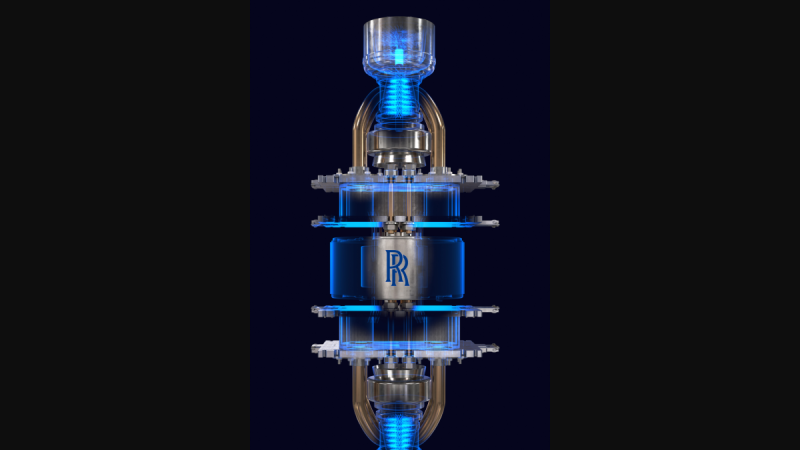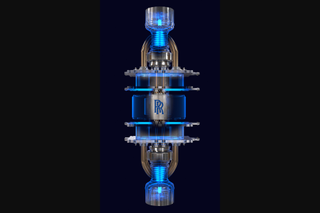Rolls-Royce unveils early design for space nuclear reactor | Space
Category: Health, Science & Technology
Via: evilgenius • 2 years ago • 5 commentsBy: Elizabeth Howell (Space. com)




A rendering of Rolls-Royce's proposed space micro-nuclear power system.(Image credit: Rolls-Royce)
A new image shows a possible version of future space propulsion.
Nuclear fission systems, which harness the energy released in the splitting of atoms, could be used to power astronaut bases on the moon or Mars. Or they could help shorten the travel time to the Red Planet, which takes six to nine months to reach with current-generation propulsion systems.
Rolls-Royce could be a part of that ambitious spaceflight future. The venerable company released an early-stage design of a micro-nuclear reactor on Friday (Jan. 27), in the wake of a 2021 agreement (opens in new tab) with the United Kingdom Space Agency to study future nuclear power options in space exploration.
"Each uranium particle is encapsulated in multiple protective layers that act as a containment system, allowing it to withstand extreme conditions," Rolls-Royce tweeted (opens in new tab) in a brief description of the system.
Related: NASA funds nuclear probes for icy moons, huge new space telescopes and other far-out tech ideas
Nuclear systems have long flown on robotic space missions. For example, radioisotope thermoelectric generators (RTGs) provide electricity for many probes, including NASA's Voyager 1 and Voyager 2 spacecraft, which are currently exploring interstellar space. Big NASA Mars rovers like Perseverance and Curiosity also use RTGs, though smaller rovers such as Spirit and Opportunity went with solar panels.
But RTGs are not fission reactors. Rather, they are nuclear batteries, converting to electricity the heat thrown off by the decay of radioactive material. Nuclear fission has yet to power a spacecraft off Earth, though that could change soon; for example, NASA and DARPA recently announced plans to build a nuclear thermal rocket by 2027.
Nuclear fusion — the power source of the sun and other stars, which flows from the merging of atoms — could also one day be part of humanity's spaceflight portfolio. That possible future is a long-term one, however; our species has yet to harness this power source here on Earth. (But U.S. scientists did announce a big breakthrough recently: a fusion experiment that produced more energy than it consumed.)
Speaking generally, some of the concerns of space fission or fusion power include safety for astronauts; portability, as more mass means a more expensive mission; and longevity in a harsh and rugged environment.
But nuclear power is a staple of space exploration nonetheless, both in reality and in science fiction. The technology even helped fuel a joke in the 2015 movie "The Martian." In the film, astronaut Mark Watney (played by Matt Damon) — in search of warmth in an unheated rover and desperately digging up a reactor buried in regolith for safety reasons — said his Red Planet training manual had a section about surface operations labeled "Don't Dig Up The Big Box of Plutonium, Mark."
Elizabeth Howell is the co-author of " Why Am I Taller (opens in new tab) ?" (ECW Press, 2022; with Canadian astronaut Dave Williams), a book about space medicine. Follow her on Twitter @howellspace (opens in new tab) . Follow us on Twitter @Spacedotcom (opens in new tab) or Facebook (opens in new tab) .
Join our Space Forums to keep talking space on the latest missions, night sky and more! And if you have a news tip, correction or comment, let us know at: community@space.com.

Elizabeth Howell, Ph.D., is a staff writer in the spaceflight channel since 2022. She was contributing writer for Space.com (opens in new tab) for 10 years before that, since 2012. Elizabeth's reporting includes an exclusive with Office of the Vice-President of the United States, speaking several times with the International Space Station, witnessing five human spaceflight launches on two continents, working inside a spacesuit, and participating in a simulated Mars mission. Her latest book, "Why Am I Taller?", is co-written with astronaut Dave Williams. Elizabeth holds a Ph.D. and M.Sc. in Space Studies from the University of North Dakota, a Bachelor of Journalism from Canada's Carleton University and (soon) a Bachelor of History from Athabasca University. Elizabeth is also a post-secondary instructor in communications and science since 2015. Elizabeth first got interested in space after watching the movie Apollo 13 in 1996, and still wants to be an astronaut someday. Mastodon: https://qoto.org/@howellspace

Tags
Who is online
413 visitors

I wonder if the space craft will get one of those cool hood ornaments? Kidding aside this is really cool. We are making astonishing advances in space technology. I just can't help but wondering if I'll ever see pictures of the surface of the closest Earth like planet.
I read an article the other day that said we will only be able to explore our own galaxy.
Even if we could travel at the speed of light, some galaxies are moving away from us faster than that. We could never catch up to them.
“…able to explore our own galaxy.”
Kinda off topic, but saw this somewhere…the reason we haven’t found intelligent life out there is they don’t consider us worth the effort. Cool post though.
I hate to bring this into your article but if they plan on unveiling a new rocket to launch in to space, if successful, wouldn't that stop them from using Space X. That company would go defunct.
Space X is contracted by NASA for short travel vehicles that can be reused several times - think something like moon base shuttles. The Rolls company is working with the British for what looks like long distance travel - other planets.